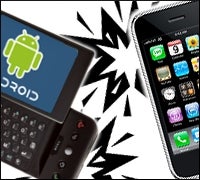 |
While Apple spends the most on the iPhone’s memory and touchscreen, HTC, the maker of the new Google Android-based G1 phone, is following the path laid out by the BlackBerry Bold and spending big on its mobile connectivity hardware, instead.
A new study by iSuppli found that the hardware and components in the HTC G1 phone cost $143.89 — about $30 less than the Apple (NASDAQ: AAPL) iPhone 3G, which cost $173 to build, and $27 less than the Research in Motion (RIM) BlackBerry Bold that cost $170 for its internal components, according to iSuppli.
The devices’ difference in price tags are far greater. AT&T, Apple’s exclusive U.S. carrier, prices the basic iPhone 3G at $200 with the signing of a contract, while the Bold, sold by both Verizon Wireless and AT&T (NYSE: T), goes for $300. In comparison, G1 carrier T-Mobile is selling its device for $179 with a contract signing.
The findings are based on a study conducted by the research firm, known for detailed “teardown” analysis of product manufacturing costs, and released in its G1 Bill-of-Materials (BOM) analysis on component and material expenses.
The report comes as smartphone players and carriers vie for more users and market share by dangling reduced plan rates, expanded mobile services and flashy new handset features like downloads and high-speed Internet access. And as the holiday season approaches, handset manufacturers and carriers are widely expected to ramp up the already white-hot competition.
That’s likely to come against a backdrop of an increasingly crowded marketplace for advanced smartphones. The Android handset, one of the year’s most highly anticipated rivals to the iPhone, faces stiff competition not just from Apple. It’s also squaring off against a slew of new BlackBerry devices as well as offerings from a number of high-profile competitors.
The most expensive G1 part is its baseband, the microprocessor needed for multimedia and modem functionality. That piece costs $28.49 and represents 19.8 percent of the total BOM.
iSuppli, which released a breakdown of BlackBerry Bold costs earlier this month andan iPhone analysis in early summer, said RIM (NASDAQ: RIMM) spent $34.34 for its handset baseband. The iPhone’s baseband is priced at $15.
The G1’s second most-expensive component is its 3.2-inch flat touch-sensitive display, which cost $19.67, or 13.7 percent of the BOM. G1’s 3-megapixel camera is its next priciest part, with a cost of $12.13 — about 8.4 percent of total BOM. Another key element is the radio frequency/power amplifier that supports 3G network capability. It costs $9.84, about 6.8 percent of the total bill.
Apple, on the other hand, made its largest spend on the iPhone’s 8GB NAND flash memory ($22) and its touchscreen display ($20), according to iSuppli. The iPhone display is multitouch, however, while the G1’s screen is not.
Factoring in Android
The researcher’s analysis doesn’t include expenses related to software, research and development, manufacturing and accessories, however. And it’s costs relating to developing its mobile operating system that may make all the difference for HTC and T-Mobile in helping them reap a financial reward from the G12, according to iSuppli.
At the heart of the G1 is the open source Android software, developed by a consortium of vendors led by Google (NASDAQ: GOOG), and which is free to license and modify — potentially making it more appealing to handset makers than licensing a proprietary OS or laying out the money to develop one from scratch.
Android also offers key benefits in functionality, iSupply said.
“The G1’s differentiation is its use of the Android operating system, which has won praise for its ease of use, but whose major advantage is its integration with Google Internet services and its capability to accommodate the flood of free applications that are becoming available,” according to a statement from iSuppli.
The researcher also said it expects the G1’s market share will grow as users flock to its free, open source applications. As its user base grows, carriers also will have greater opportunity to push out paid mobile services such as games, music and location-based services for monthly fees, the company said.
“Eventually, the G1 will have its own software community, much like the Linux applications in the wired world or the Sun OS has for workstations,” Tina Teng, iSuppli analyst, said in the report.
“This will produce a rich suite of free software for a variety of purposes that anyone can access,” she added.


